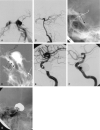Endovascular treatment of high-flow carotid cavernous fistulas by stent-assisted coil placement
- PMID: 15956506
- PMCID: PMC8149099
Endovascular treatment of high-flow carotid cavernous fistulas by stent-assisted coil placement
Abstract
Background and purpose: Endovascular techniques are the methods of choice for the treatment of patients with carotid cavernous fistulas. We report our experience using stent-assisted coil placement for treatment of patients with high-flow fistulas that are associated with severe laceration of the internal carotid artery.
Methods: In a retrospective review of an internal endovascular therapy database covering the interval between October 2001 and October 2003, we identified a total of 5 patients presenting with 6 high-flow type A carotid cavernous fistulas (one had a bilateral fistula) that were associated with severe laceration of the internal carotid artery. All were treated first with stenting of the injured segment of the internal carotid artery followed by transarterial (3/6) and/or transvenous (4/6) obliteration of the fistula with detachable platinum coils. In 2 cases, a liquid adhesive was also used. In all instances, a compliant balloon was inflated within the stented arterial segment during coil deposition to avoid extension of coils into the parent artery.
Results: All 6 fistulas were obliterated, and each internal carotid artery was successfully reconstructed. Except for posttraumatic cranial nerve dysfunction in 1 patient, clinical outcome was very good. Follow-up angiograms in 3 of the 6 patients obtained at intervals between 3 and 6 months (mean, 4.5 months) revealed no fistula recurrence and no evidence of intimal hyperplasia within the stent.
Conclusion: In this series of patients with high-flow carotid cavernous fistula associated with severe injury to the internal carotid artery, stent-assisted coil placement offered a safe and effective treatment. Stent-assisted coil placement may increase the ability to successfully treat fistulas with severe injury to the internal carotid artery with preservation of the parent artery.
Figures



References
-
- Barrow DL, Spector RH, Braun IF, Tindall SC, Tindall GT. Classification and treatment of spontaneous carotid-cavernous sinus fistulas. J Neurosurg 1985;62:248–56 - PubMed
-
- Debrun GM, Vinuela F, Fox AJ, Drake KR, Ahn HS. Indications for treatment and classification of 132 carotid-cavernous fistulas. Neurosurgery 1988;22:285–289 - PubMed
-
- Lewis A, Tomsick TA, Tew JJ. Management of 100 consecutive direct carotid cavernous fistulas: results of treatment with detachable balloons. Neurosurgery 1995;36:239–244 - PubMed
-
- Lee CY, Yim MB, Kim IM, Son EI, Kim DW. Traumatic aneurysm of the supraclinoid internal carotid artery and an associated carotid-cavernous fistula: vascular reconstruction performed using intravascular implantation of stents and coils—case report. J Neurosurg 2004;100:115–119 - PubMed
-
- Ahn JY, Lee BH, Joo JY. Stent-assisted Guglielmi detachable coils embolization for the treatment of a traumatic carotid cavernous fistula. J Clin Neurosci 2003;10:96–98 - PubMed
MeSH terms
LinkOut - more resources
Full Text Sources
